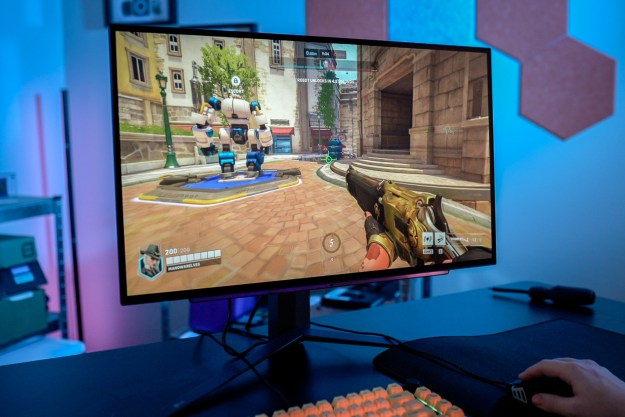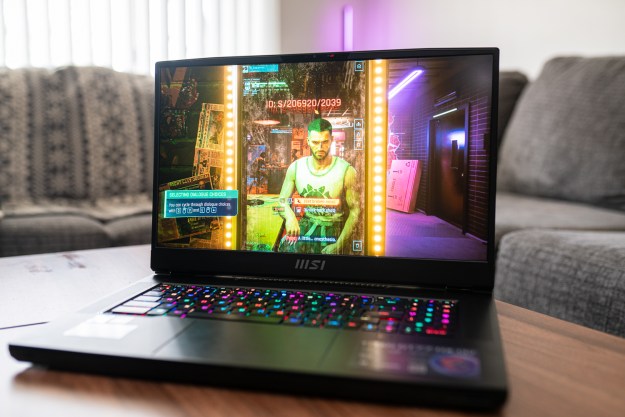Origin has never been one to hype up new products with big press conferences, or a lot of fanfare. That’s probably for the best with its new product, the Omni gaming all-in-one. It likely would’ve resulted in laughter, and PC gamers wondering whether one of our favorite gaming PC companies had gone off the rails.
But Origin is going to be the one laughing — all the way to the bank, after launching the Omni. This slick all-in-one boasts the fastest Core i7 processors, up to an Nvidia Titan X video card, a curved 34-inch 1440p display, and has one key trait that almost every other all-in-one misses. It’s upgradeable.
Will the Omni convince gamers that it’s time to reexamine the AIO?
Looks the same, but feels different
Look at it from the front, and there’s nothing particularly impressive about the Omni. Its black bezel and three-prong stand are commonplace, and not a little boring. Still, PC gamers who appreciate the more understated look to their hardware will appreciate that. It’s also designed to fit into a small space, where a user might not have room for a full size desktop. It succeeds there admirably, with all of the internals fitting flush with the curved back on the unit. There’s an optional back window, to admire the components.

What makes the Origin Omni different from other AIOs isn’t just the components that are in it, but the way they’re installed. The motherboard sits dead center on the back of the panel, with the graphics card to the right of it, vertically mounted. Everything is accessible and upgradeable, from the CPU to the GPU, and even the Mini-ITX motherboard, if you have a bit of time on your hands.
But a gaming computer isn’t just about a fast processor and a powerful graphics card. The display is a big part of the equation, too. Origin knows that all too well, so the Omni is wrapped around a curved 34-inch, 1440p panel. It only boasts a 60Hz refresh rate, but that’s fairly standard for this type of monitor. Through HDMI in, the screen can even double as a TV, sharing the screen with the computer via picture-in-picture.
Approaching top speed
The Omni offers a standard selection of ports for a Mini-ITX motherboard, with the I/O panel facing downward. That means HDMI, USB 3.0 – whatever is included with the motherboard you choose. Z170 and X99 chipsets are available, with processor options up to a Core i7-5960X. It supports up to 32GB of DDR4 RAM, up to two SSDs, and a full-length graphics card.
The specs are excellent, but they make a few concessions from Origin’s normal lineup.
Those specifications are excellent, but they make a few concessions from Origin’s normal lineup. First, there’s a distinct lack of multiple GPUs. Granted, the 1440p screen means that’s not a huge deal, assuming you pick a capable card for the task, but the most demanding gamers will be disappointed. Second, the system is well cooled with Origin’s in-house liquid cooling, but it’s already pushing the upper end on heat, so overclocking, at least from the factory is out of the question.
Those are issues that are only going to affect the most devout PC gaming enthusiasts, but unfortunately, that’s Origin’s target audience. If the Omni is going to find success, those are the gamers it has to convince.
Make or break
The question that Origin is exploring is not “Can you fit a high-end gaming rig into an AIO?” The answer is yes, and the Omni is proof positive. Rather, the question is whether PC gamers are ready to take a second look at a form factor that’s been completely written off by anyone who wants a high-end computer. The answer there isn’t as clear cut.
A lot of that uncertainty revolves around the breakneck pace of PC gaming. What looks like enough wattage or room for a card now may not be a year or two down the road.
When the system goes on sale sometime in the first quarter of 2016, it will start at $2,000. Origin’s rigs are highly customizable, so expect a setup with a 5960X and Titan X to run much higher than the base cost. That’s far from cheap, but not unreasonable considering systems like the HP Envy 34 are also in that range. And it starts to look cheaper when you consider the $800+ cost of a 34-inch curved monitor. If any brand is going to bring gamers around to give an all-in-one a shot, it’s Origin.
Editors' Recommendations
- The Asus ROG Ally just got a game-changing update
- Lenovo just made my favorite gaming laptop even better
- Samsung’s new OLED gaming monitor might have a problem
- AMD’s new anti-lag tech could land you with a ban in games
- All ray tracing games on PC: AMD Radeon and Nvidia RTX ray tracing



